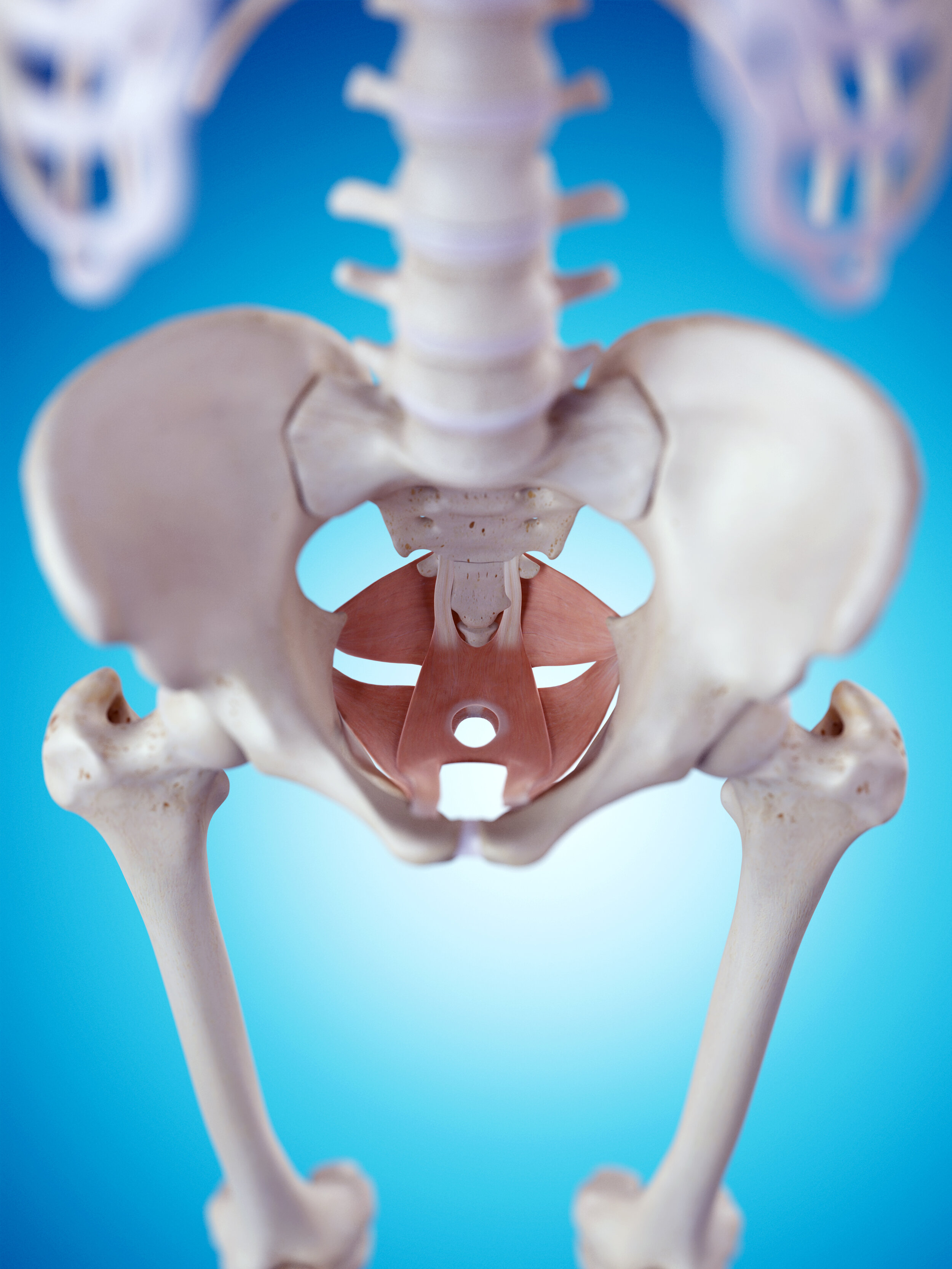The Pelvic Star: Pelvic Diaphragm and Myofascia Connections Influences Movement
The bony pelvis creates a bowl and ring-like shape to support and house our internal organs. The pelvis is also the Grand Central Station of the body connecting the trunk with the legs. Spinal and hip joint movement articulates and instigates pelvic movement. The subtle motions of the pelvis are found in the SIJ and deep femoral head spinning. The lumbo-pelvi-hip complex balance is the key to unlocking pelvic pain and discomfort.
The pelvic viscera live within the pelvic cavity, or what we call the pelvic outlet. This cavity is located within the smaller part of the pelvis and has a number of muscles and fascia that help make up its walls.
When you tug on connective tissues and muscles, you can see how the pelvic diaphragm moves and changes its dynamic. For example, if you pull the rectus abdominis, there’s a tug that happens in the pelvic diaphragm. When you move your legs, especially in adduction, the adductors pull directly on the pelvic diaphragm. And when it is balanced it aids in creating support for the pelvis.
Ultimately, everything is connected.
With everything being connected, it’s important to understand how movement and lines of tensions pull in one area and significantly impact another.
Let’s explore how the pelvic diaphragm is impacted by movements and the connections from above and below. More specifically, let’s examine pain, scarring and the overall pelvic star connections.
PAIN AND UNWANTED DISCOMFORTS
There are so many variables and ways to describe pelvic pain—sacroiliac (SI) joint pain, hip joint pain, pubic bone pain, and more. When addressing pelvic pain, never chase the pain. It is wise to assess the whole system, specifically the lumbo-pelvi-hip complex. The issue causing the discomfort is rarely where the pain manifests in the body. For example, one may exhibit pain in SIJ. This joint and its ligaments are being strained by an imbalance in the pelvic movement patterning. Change the pattern and the pain is relieved in most cases.
Questions to think about are:
How does the pelvis move?
What’s inhibiting the movement?
Is the motion of the pelvis stimulating proper lumbar and hip joint motion?
Consider the function of the feet and thorax, are they inhibiting good pelvis motion?
When your client identifies pelvic and pelvic diaphragm discomfort or pain, the temptation is to work on the side that has pain. Instead, you want to identify an overall understanding of where hypomobility and hypermobility exists. Then, address balancing the lumbo-pelvi-hip complex to alleviate the pain and, ultimately, the area of discomfort.
Any sort of non-myofascial skeletal issue in the pelvis such as the intestines may create movement problems as well with the lack of organ motility. Motility is the natural movement of the organs. Scar tissue from surgeries in this area causes movement restriction. Scars may appear small but they run deep and continue to evolve. A superficial scar is like seeing the tip of the iceberg.
SCARRING
People have various forms of fascial adhesions and distortions with injuries and scar tissue. Scarring from surgery or a tear, as in pelvic diaphragm tears from birth, the connective tissue lays down new tissue for healing the wound. Each person heals differently. No two scars are the same. Scars change the way the myofascial lines of tension affect movement function. (Xui 2015)
In surgery, there are various ways the surgeon approaches the entry and reattaching or not the muscles. Often, muscles and fascia are not reattached after surgery because it results in higher pain levels for the post-op patient. This is quite interesting when the layers are left open. Surgeons essentially pick and choose which layers to reattach. It is curious to think about how the process of repair after surgery with its reattachments and no reattachments heals and effects movement function.
Breathing helps with scar tissue restrictions and remodeling of the extracellular matrix. When something is torn naturally, the tearing happens along the line of skin tensions (Son 2014). With a surgical cut, the tearing happens across the lines of tension and the healing process results in a distortion of the extracellular matrix by laying down non-parallel lines of connective tissues. The way to restructure and bring movement into the distortion is through manual therapies, movement, breath, hydration, and creating a different torque on the connective tissue such as improving movement patterning.
Scar tissue is not just a surgical outcome.. Rather, it’s much more broad. It holds many complex emotions, trauma, and a reminder of an event that caused scar. It is a memory, a sign of being a survivor.
Thank you, Marimba Gold-Watts for the contribution of bringing the scarring topic into this conversation.
THE PELVIC STAR CONNECTION
The continuous connections of the trunk to the pelvis and legs to the pelvis create an image of a star. The rectus abdominis runs from the mid sternum to pubic bone with its continuous connections with the pectoralis above and pubococcygeus below as it travels over and under the pubic symphysis. It makes the vertical lines of a star. The other limbs of the star arise diagonally from the obliques and vertically below from the adductors that merge into the pelvic diaphragm.
The deep myofascia of the pelvic outlet essentially forms an arc around and inside the bowl of the pelvis. The pelvic diaphragm can be felt and seen as a very fluid, spongy, trampoline-like structure. Because of this, there is a trampoline-like movement effect with the pelvic diaphragm.The pelvic diaphragm and thoracic diaphragm move together to create more or less pressure depending on what your body needs at the moment.
The hip joint is embedded in the pelvic diaphragm. When you look at the myofascia of the hip, these tissues travel from the femoral neck and greater trochanter and pass through laterally and glide along one another. And the pelvis sits on two balls, balancing on the femoral heads. There’s a real conversation going on between the hip joint and the pelvis. It all impacts the buoyancy of the pelvic floor, which itself is more of a broad structure.
As you can see, there is quite a bit at play here.
Let’s look at things even further, the pelvic torque.
Everyone lives in some sort of a spiral. The spiral is a torque that is created from the lumbo-pelvi hip complex and adding the feet and thorax. The myofascial lines of tension pull and create torque, with one side with more tension and other side less tension. The pelvis will reflect this imbalance of tensional pulls by moving into a spiral pattern.
We all have our own unique pattern and you need to pay attention to your pattern to manage discomforts or pain. When your pattern starts to be more amplified, pay attention and start to do certain movements based on your pattern in order to reset your pelvis. This will help alleviate the issue.
Understanding the optimal movement patterns of the lumbo-pelvi-hip complex gives you the ability to discover your pattern and habits. Practicing specific movements that unwind your spiral into a more balanced system makes movement more joyful and pain-free.
References
Xue M, Jackson CJ. Extracellular Matrix Reorganization During Wound Healing and Its Impact on Abnormal Scarring. Adv Wound Care (New Rochelle). 2015;4(3):119-136. doi:10.1089/wound.2013.0485
Son D, Harijan A. Overview of surgical scar prevention and management. J Korean Med Sci. 2014;29(6):751-757. doi:10.3346/jkms.2014.29.6.751

